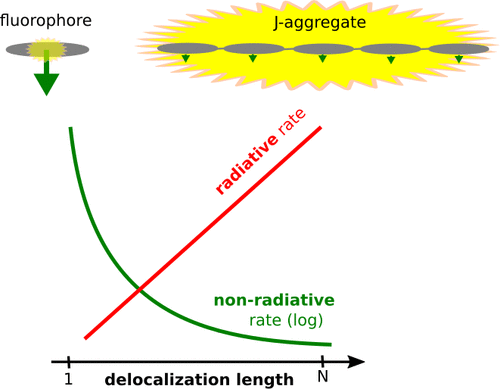当前位置:
X-MOL 学术
›
J. Phys. Chem. A
›
论文详情
Our official English website, www.x-mol.net, welcomes your
feedback! (Note: you will need to create a separate account there.)
Size Dependence of Non-Radiative Decay Rates in J-Aggregates
The Journal of Physical Chemistry A ( IF 2.7 ) Pub Date : 2020-11-27 , DOI: 10.1021/acs.jpca.0c09074 Alexander Humeniuk 1 , Roland Mitrić 1 , Vlasta Bonačić-Koutecký 2
The Journal of Physical Chemistry A ( IF 2.7 ) Pub Date : 2020-11-27 , DOI: 10.1021/acs.jpca.0c09074 Alexander Humeniuk 1 , Roland Mitrić 1 , Vlasta Bonačić-Koutecký 2
Affiliation

|
Fluorophores that emit in the near-infrared (NIR, 700–1700 nm) and have high quantum yields are urgently needed for many technical applications such as organic light-emitting diodes or bioimaging. The design of such chromophores is hampered by the energy gap law, which states that shifting the emission to lower wavelengths is accompanied by a dramatic increase in the nonradiative decay rate. In this article we argue that linear oligomers with J-type excitonic coupling are ideal NIR fluorophores because of the advantageous dependence of the emission energy and the radiative and nonradiative rates on the length N over which the excitation is delocalized. The lowering of the emission energy due to exciton splitting and the linear increase of the radiative rate with length (super-radiance) are well understood. However, less attention has been paid to the decrease of the nonradiative rate with length, which can compensate for the exponential increase due to the energy gap law. According to the exciton model, the Huang–Rhys factors decrease like N–2 while the strength of the nonadiabatic coupling remains approximately constant. Plugging these relations into the Englman–Jortner’s energy gap law, we show that for excitonic coupling that is not too strong the nonradiative rate decreases quickly with N. This phenomenon explains the decrease of the nonradiative rate with length in J-aggregates of carbocyanine dyes and the exceptionally high fluorescence quantum yields of linear ethyne-linked zinc-porphyrin arrays, which seemed to defy the energy gap law.
中文翻译:

J聚集体中非辐射衰变率的大小依赖性
在许多技术应用(例如有机发光二极管或生物成像)中,迫切需要发出近红外光(NIR,700-1700 nm)并具有高量子产率的荧光团。这种发色团的设计受到能隙定律的阻碍,该定律指出,将发射移至较低波长会伴随着非辐射衰减率的急剧增加。在本文中,我们认为具有J型激子耦合的线性低聚物是理想的近红外荧光团,这是因为发射能量以及辐射和非辐射速率对长度N的有利依赖性激励在其上是离域的。众所周知,由于激子分裂导致的发射能量的降低以及辐射速率随长度(超辐射)的线性增加。但是,随着长度的增加,非辐射速率的降低引起了人们的关注,这可以弥补由于能隙定律引起的指数增长。根据激子模型,Huang–Rhys因子像N –2一样下降,而非绝热耦合的强度保持近似恒定。将这些关系代入Englman-Jortner的能隙定律,我们表明,对于激振耦合不是太强的情况,随着N的增加,非辐射速率迅速降低。这种现象解释了碳花青染料的J聚集体中非辐射速率随长度的降低以及线性乙炔连接的锌卟啉阵列的异常高的荧光量子产率,这似乎违反了能隙定律。
更新日期:2020-12-10
中文翻译:

J聚集体中非辐射衰变率的大小依赖性
在许多技术应用(例如有机发光二极管或生物成像)中,迫切需要发出近红外光(NIR,700-1700 nm)并具有高量子产率的荧光团。这种发色团的设计受到能隙定律的阻碍,该定律指出,将发射移至较低波长会伴随着非辐射衰减率的急剧增加。在本文中,我们认为具有J型激子耦合的线性低聚物是理想的近红外荧光团,这是因为发射能量以及辐射和非辐射速率对长度N的有利依赖性激励在其上是离域的。众所周知,由于激子分裂导致的发射能量的降低以及辐射速率随长度(超辐射)的线性增加。但是,随着长度的增加,非辐射速率的降低引起了人们的关注,这可以弥补由于能隙定律引起的指数增长。根据激子模型,Huang–Rhys因子像N –2一样下降,而非绝热耦合的强度保持近似恒定。将这些关系代入Englman-Jortner的能隙定律,我们表明,对于激振耦合不是太强的情况,随着N的增加,非辐射速率迅速降低。这种现象解释了碳花青染料的J聚集体中非辐射速率随长度的降低以及线性乙炔连接的锌卟啉阵列的异常高的荧光量子产率,这似乎违反了能隙定律。











































 京公网安备 11010802027423号
京公网安备 11010802027423号